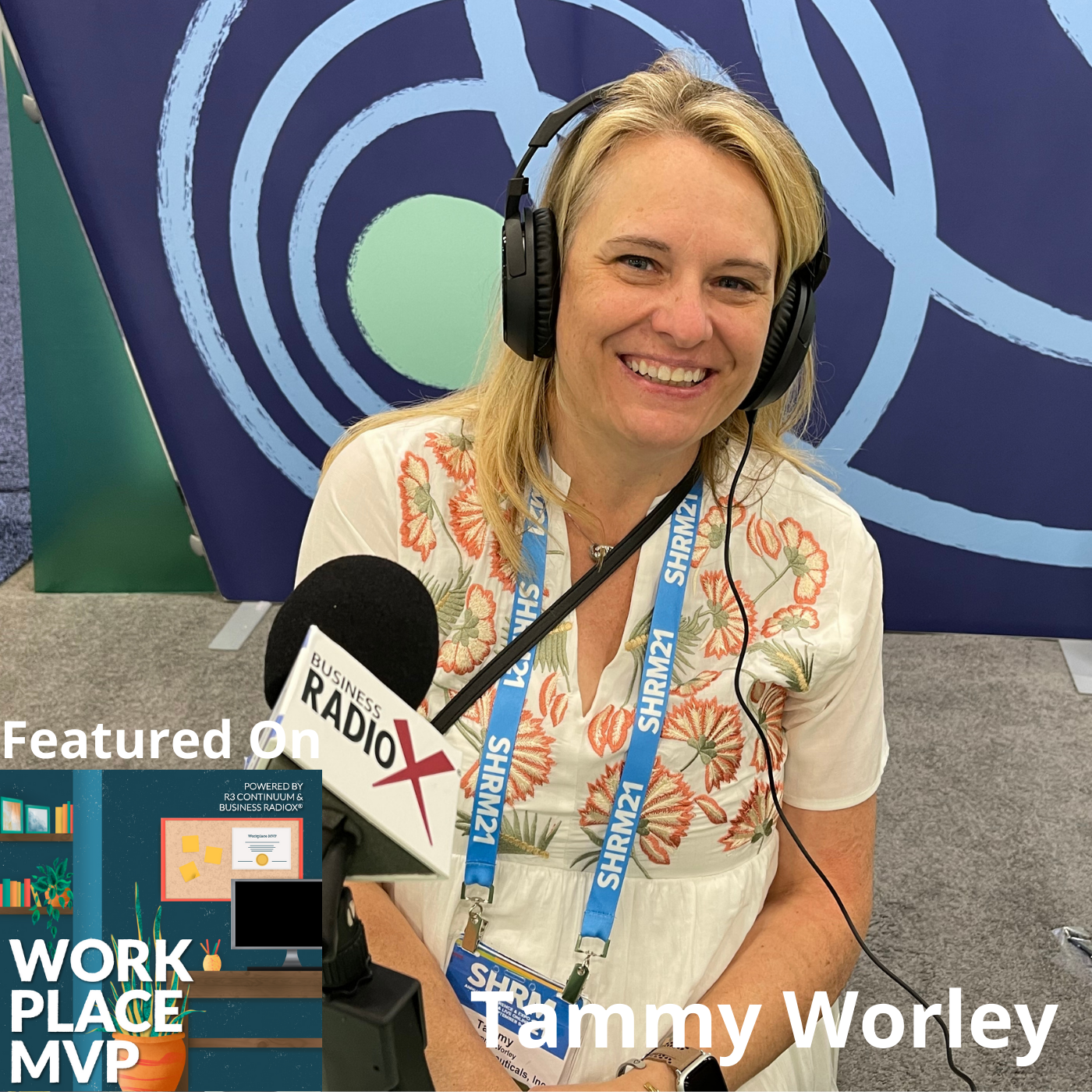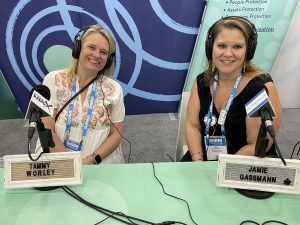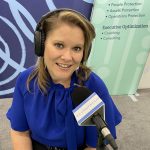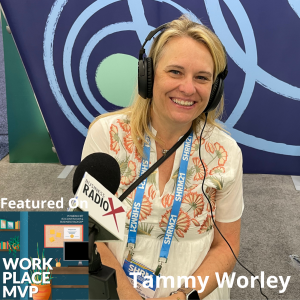
Workplace MVP LIVE from SHRM 2021: Tammy Worley, Adare Pharma Solutions
On this live edition of Workplace MVP, Adare Pharma Solutions Sr. HR Manager Tammy Worley related not only her path to HR but shared how the SHRM 2021 conference has reaffirmed her belief that the whole person comes to work. As she shared with host Jamie Gassmann, employees aren’t looking for another newsletter; they are looking for better communication and connection. Workplace MVP is underwritten and presented by R3 Continuum and produced by the Minneapolis-St.Paul Studio of Business RadioX®.
This show was originally broadcast live from the 2021 SHRM Annual Conference held at the Las Vegas Convention Center in Las Vegas, Nevada.

Tammy Worley, Sr. Manager, Human Resources – US, Adare Pharma Solutions

Tammy Worley fell in love with HR in 1996. She realized it combined her love of compassion for people and education. Tammy has been with Adare since 2017 and in 2020 became the Senior Manager of Human Resources in the US for Adare.
Adare Pharma Solutions
Adare is a global specialized CDMO company with a long history of success from concept through commercialization. We use our unique combination of experience, proprietary capabilities, and resources to create meaningful products for our customers. Our ability to create differentiated drugs guides the identification and development of the novel products in our pipeline and our acquisition strategy. Our dedication to developing strong, collaborative partnerships provides significant advantages in competitive markets.
About Workplace MVP
Every day, around the world, organizations of all sizes face disruptive events and situations. Within those workplaces are everyday heroes in human resources, risk management, security, business continuity, and the C-suite. They don’t call themselves heroes though. On the contrary, they simply show up every day, laboring for the well-being of employees in their care, readying the workplace for and planning responses to disruption. This show, Workplace MVP, confers on these heroes the designation they deserve, Workplace MVP (Most Valuable Professionals), and gives them the forum to tell their story. As you hear their experiences, you will learn first-hand, real-life approaches to readying the workplace, responses to crisis situations, and overcoming challenges of disruption. Visit our show archive here.
Workplace MVP Host Jamie Gassmann

In addition to serving as the host to the Workplace MVP podcast, Jamie Gassmann is the Director of Marketing at R3 Continuum (R3c). Collectively, she has more than fourteen years of marketing experience. Across her tenure, she has experience working in and with various industries including banking, real estate, retail, crisis management, insurance, business continuity, and more. She holds a Bachelor of Science Degree in Mass Communications with special interest in Advertising and Public Relations and a Master of Business Administration from Paseka School of Business, Minnesota State University.
R3 Continuum
R3 Continuum is a global leader in workplace behavioral health and security solutions. R3c helps ensure the psychological and physical safety of organizations and their people in today’s ever-changing and often unpredictable world. Through their continuum of tailored solutions, including evaluations, crisis response, executive optimization, protective services, and more, they help organizations maintain and cultivate a workplace of wellbeing so that their people can thrive. Learn more about R3c at www.r3c.com.
Company website | LinkedIn | Facebook | Twitter
TRANSCRIPT
Intro: [00:00:03] Broadcasting live from the SHRM 2021 Conference at the Las Vegas Convention Center, it’s time for Workplace MVP. Brought to you by R3 Continuum, a global leader in workplace behavioral health, crisis, and security solutions. Now, here’s your host.
Jamie Gassmann : [00:00:22] Hello, everyone. Jamie Gassmann, your host of Workplace MVP, and we are broadcasting from the SHRM 2021 Conference in Las Vegas, Nevada. And, with me today is Tammy Worley from Adare Pharmaceuticals. Tammy is the senior H.R. manager for the U.S. region. Welcome to the show, Tammy.
Tammy Worley: [00:00:44] Thank you. I’m happy to be here.
Jamie Gassmann : [00:00:46] So, Tammy, tell me a little bit about your career journey and how you came to be the senior H.R. manager for Adare Pharmaceuticals.
Tammy Worley: [00:00:54] Wow. What a journey. I started out in a manufacturing company that was a glass factory and I was asked to volunteer to help to rewrite an employee handbook. And, from there, I fell in love with H.R. and I have been in it since 1996.
Jamie Gassmann : [00:01:14] Wow. So, all from being a volunteer to writing an HR handbook. Fantastic. How did you navigate that task?
Tammy Worley: [00:01:22] It was a lot of work, a lot of talking to people, a lot of typing because back then we did not have word processors like we have today so there was a lot of manual typing. And, it was communicating with a lot of people and having to collaborate with different groups. And, I found that when I was a child, I wanted to be a teacher and this started that journey where I could be a customer service person without having to be a teacher of young children. And, I also, at one point, wanted to be in adult care, and I knew that from my wearing my heart on my sleeve that I wasn’t going to be probably good in that arena. And, when I volunteered in H.R., it just was like, I think I found my home.
Jamie Gassmann : [00:02:19] It’s amazing. Well, it definitely brings those two, kind of, passions that you had as a child into one career opportunity because H.R. definitely does that. There’s definitely that educational component to it as an H.R. leader within an organization, and you really have to have that compassion for people, too. So, that’s fantastic.
Tammy Worley: [00:02:38] Yeah. And, it was just a way that, you know, if in the adult care, elder care, you know, you’re going to be looking at the loss of individuals. Not that I don’t see a loss of people, but it’s on a different scale. But it’s a way for me to connect with people, do all I can to support them because I heard it during the session, the general session, it’s the whole person comes to work, and I heard Chipotle mentioned that. And, that has actually been a belief of mine for as long as I can remember. The whole person comes to work and the whole person goes home. And how can you ask people to differentiate from that? And I can’t because I am the whole person that comes to work and I’m the whole person that goes home. So, how can I ask people to be different from me? I can’t.
Jamie Gassmann : [00:03:37] That’s a fantastic takeaway. I love that. And it’s true. You got to look – it’s all of it. It’s the physical. It’s the psychological. You got to look at that entire person and how you’re supporting them.
Jamie Gassmann : [00:03:48] So, having that belief and then hearing that in one of the pre-conferences, oh, actually, it was the general session, was like, opening keynote. Is there something that you are taking back that’s different than what you might have been doing already, or is it going to enhance some of the things that you maybe have done already in your role?
Tammy Worley: [00:04:06] I think it’s an affirmation that what I have believed all along is accurate. You know, I’m a person entering the H.R. arena in the ’90s, and that was a whole different world. And Brian spoke about, you know from Chipotle, that there was one person who said a new normal. And, I agree with him that our new normal is changes daily.
Jamie Gassmann : [00:04:41] Absolutely.
Tammy Worley: [00:04:42] And, as an H.R. professional how do we recognize that that new normal is going to change daily but we answer to different people who don’t necessarily agree that the new normal is daily. I love the fact that he, as a high-level leader within the organization, recognizes that.
Jamie Gassmann : [00:05:01] Yeah. That’s fascinating because, you know, it’s a new normal at work daily. It’s also a new normal at home daily for some of these employees. So, they’re bringing that on their sleeve when they’re coming into that workplace. They’re trying to balance the challenges that they’re experiencing on their daily at home with the challenges they face daily at work. So, what a great takeaway.
Jamie Gassmann : [00:05:20] And so, you know, how, you know – from your perspective, if you’re going to be looking at, like, maybe a senior leader in your organization that you’re having to kind of talk about that with, you know, how would you approach that?
Tammy Worley: [00:05:39] Well, it’s really a cultural difference. We went from an autocratic organization, most organizations are autocratic, to more of a demographic or democracy, if you will, asking employees. What do you think? What do you feel? Where do you want to see things? Having focus groups.
Tammy Worley: [00:06:01] I mean a lot of organizations were breaking that ground and other organizations were not jumping onto that bandwagon. They were still in a this is what we have to do and we’re very controlled environment and it’s black and white but now we’re in a gray environment. We have remote workers and these remote workers want to stay remote. We had to introduce flexible work environments because we have people that are taking care of their children at home.
Tammy Worley: [00:06:37] And so, that new normal became a different demographics for us, and we had to rethink how we administer policies, how we administer compassion, how we integrate communication, you know. So, it was a divide and conquer, but at the same time thinking about how do we re-engage people because engagement is important. And I know every pulse survey every company does, it comes out communication. But employees are not asking for us to give us another newsletter. They’re not asking us to send another email. They’re not asking for another video. They’re asking for us to bridge the gap from department to department. And, they want to bridge that gap of communication.
Tammy Worley: [00:07:33] And so, when you have remote workers, there’s a delay in communication. It’s not real-time anymore. So, we have to figure out how to engage the employees to recognize that if you’re asking for email, you’re asking for teams meetings or Skype meetings or whatever the case may be, that we’re no longer asking employees, send me an IM, let’s open up the door to give me a call, and have a real-life conversation because I think email has become the norm communication and there’s something lost in that.
Tammy Worley: [00:08:15] Because I know from my own personal experience. I send an email. I can be short and sweet. And then, the person reads that, and then they interpret something different than the message I wanted to present. If we had just picked up the phone and called that person or said let me call you on teams or IM or Skype, we could have eliminated all of that confusion. But I think that the bridge is communicating interdepartmentally and silos have been built, and we’ve got to get the silos back down.
Jamie Gassmann : [00:08:50] Oh, I think that’s such a great point. I always say things are lost in translation and in email. And on top of that, you know, people are, they’re burned out. They’re stressed and they’re getting a lot of emails from a lot of different sources. And so, I would agree with you. Like, they’re probably skimming it, you know, and not really reading it. And, you know, it’s kind of like when you hear communication with when you talk and listen to someone like that active listening skills. It’s almost like you have to have active reading skills. And, when you’ve got so many things coming at you, I could see where some of those employees are struggling with that, which does create kind of some divides because – and those silos are hard to break down once they’re formed.
Tammy Worley: [00:09:32] Yes, and we have, in the past, you could just get up from your chair and go to the other office and talk to the person if you were not understanding. We can’t do that so much today, right?
Jamie Gassmann : [00:09:45] Right. Yeah.
Tammy Worley: [00:09:45] Because their office is at their home where the dog is barking, the cats walking across their keyboard, or the child is crying in the background. And so, we need to remember that.
Jamie Gassmann : [00:10:00] Wow. That sounded like a school bell here. Speaking of interruptions during different work and events. I’m not sure what that was, but, yeah, no, absolutely there are a lot more distractions sometimes with people working from home.
Jamie Gassmann : [00:10:16] So, in your opinion, if an organization is going to, you know – that’s a cultural thing, right, and I’m always a firm believer that cultural changes and things of that nature start at the top and then they kind of, you know, move their way through the organization. And so, as leaders, do you think that it has to be like a program implemented or is it something that you just have to get that buy-in from your executive team or your leaders and kind of saying this is now the expectation culturally that you pick up the phone and you make that phone call.
Tammy Worley: [00:10:51] I think it has to be a top-down.
Jamie Gassmann : [00:10:53] Absolutely.
Tammy Worley: [00:10:54] Because I find that our executive leadership is leading from an email. And, they do town halls, they do the pulse surveys, they do all of that. But it’s still disengaged, right? It’s not personable. Where is the personable touch to that?
Tammy Worley: [00:11:15] So, our organization is trying to do more onboarding, calling, welcoming the person to the organization from a one-on-one standpoint, and then asking them, what would you like to see differently? And then, we are actively looking to make changes based on that critique. So, that feedback is important to us. But I think there’s a lot of work that still needs to be done from the top down.
Jamie Gassmann : [00:11:43] Yeah. Interesting. I know it’s – I heard one time from an executive leader that making rounds on the floor to check in on people just to see how they’re doing, like building that into your day. It’s almost like you got to find a way to do that virtually, you know, whether it’s joining in on a team meeting. That’s not a town hall but, like, kind of individual department team meetings just to kind of show that face and let them know that you’re there and you care.
Tammy Worley: [00:12:10] Yeah. But when you have an essential workforce, they have to be there day in and day out. And then, you’ve identified those people that are not essential to the day-to-day operation. And, I almost guarantee you that’s been H.R. folks, customer service folks, maybe finance, and maybe even your individual site leadership people that don’t have to be there on a day-to-day basis. How do we get them to reengage to do as you’re pointed out to walk on that floor? Because I’m sorry, I can take my phone out there and I can video. That’s not the same. It’s not an engagement activity.
Tammy Worley: [00:12:54] So, we have to get them back to the workforce and realize that their presence is this key to every essential employee to be there. Because for me, even when I was told I was not an essential employee, I still came to the site almost every day. Why? Because I’m H.R. My title is human resource manager. How can I take the human out of the resource? And so, I still came to the site because they needed to know that I cared enough to be there, that you had to expose yourself every day to be there on-site. I had to be there too because you have questions. And, how am I supposed to answer those questions remotely from an email? Send me an email. For employees that are still using flip phones and don’t understand the email system. So, I came on site because I felt like it was my job to still include the human in the resource that we provide because are we not a customer service?
Jamie Gassmann : [00:14:02] Yeah. Absolutely. Like an internal customer service. Love that point of you’re the human in the resource. That’s fantastic. So, now, I know this is your first SHRM that you’ve attended.
Tammy Worley: [00:14:14] Yes.
Jamie Gassmann : [00:14:15] And so far, obviously, it sounds like you’re getting some great pointers from the presentations.
Tammy Worley: [00:14:21] I love it.
Jamie Gassmann : [00:14:21] So, are there any other topics or exciting presentations you’re looking forward to attending over the next few days?
Tammy Worley: [00:14:28] The Michael Phelps is really interesting to me. A couple of years ago I really wanted Adare to change their EAP benefits and we promoted a new EAP benefit plan and I have noticed over the last year we had more utilization of that. And, it’s a very – it’s a big, passionate part of being a human resource department is providing that resource.
Tammy Worley: [00:14:54] And, I knew a couple of years ago, actually I would say almost five years ago I had an employee who lost her spouse. And, she went to use our EAP benefits and she struggled finding a counselor. That was not acceptable to me because she needed real-time assistance. And, our plan that we had in place at that time was what we want to call like “free benefit,” but it didn’t provide real benefit, real-time benefit. And so, I promoted and we utilized putting in a real-life, live online help that they can get immediately for EAP benefits. And, I have noticed an increase in the utilization of our benefits, not just from our employees but their families, and we opened up that door to our EAP benefits to being anyone living in the household.
Tammy Worley: [00:15:59] So, we know that in this modern-day, it’s not just your spouse, you as an employee, and your children, but you might have a grandchild living with you. You might have a grandparent living with you. You might have parents living with you. And they may need help, too. And so, for me, an EAP benefit isn’t just about acknowledging our employee but acknowledging their home and who might need help in that home.
Jamie Gassmann : [00:16:31] Yeah. Going back to that whole person you mentioned earlier in the conversations. Great pointers. Great information. Well, I hope you get some wonderful sessions that you take some more great content from. And, I just really want to thank you for being on our show today and appreciate you stopping by the booth.
Jamie Gassmann : [00:16:50] For all those listeners listening in, we are at Booth 4076 here in the SHRM Conference. It’s our R3 Continuum’s booth, our show sponsor. And, thank you again. Enjoy the show.
Tammy Worley: [00:17:00] Thank you. So, I have enjoyed it and I hope that somebody will take something away from this, too.
Jamie Gassmann : [00:17:06] Wonderful. Appreciate it.















